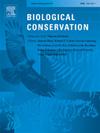Conservation needs and opportunities drive LIFE funding allocation for European birds
IF 4.9
1区 环境科学与生态学
Q1 BIODIVERSITY CONSERVATION
引用次数: 0
Abstract
Conservation resources are unevenly distributed among species and this can hamper conservation efforts. Previous research indicates that species popularity can be strongly associated with conservation funding allocation, suggesting conservation outcomes can be partly influenced by subjective human perceptions. We assessed the allocation of European Union LIFE projects targeting species conservation among European birds (548 species) and how it associates with species' conservation priorities, scientific knowledge availability, distribution, popularity and visual aesthetic attractiveness. We modelled how these factors relate to the probability that a species has received EU LIFE funding, and how many projects have targeted it. As expected given LIFE funding regulations, species listed in the EU Birds Directive Annex I are more likely to receive funding than non-listed species, and receive more projects. We also found that knowledge availability, presence in more EU member countries with access to LIFE funding, and higher conservation priority in Europe are positively associated with the probability of receiving funding, and the number of projects received. More popular species are less likely to receive conservation funding, but tend to receive more projects when allocated funding. Visual attractiveness was not associated with funding. These results suggest that pragmatic factors dominate funding allocation, but subjective factors still play a minor role. Our analysis also emphasises the need to consider non-funded species when assessing conservation funding allocation. Our findings underscore a need for targeted research on poorly-known species and opportunities for allocating conservation resources to underfunded species that need conservation action, are well-studied, and relatively popular.
保护需求和机遇推动为欧洲鸟类分配 LIFE 资金
物种之间的保护资源分配不均,这会阻碍保护工作。以前的研究表明,物种的受欢迎程度与保护资金的分配密切相关,这表明保护结果可能部分受到人类主观看法的影响。我们评估了以欧洲鸟类(548 种)物种保护为目标的欧盟 LIFE 项目的分配情况,以及它与物种保护优先级、科学知识可用性、分布、受欢迎程度和视觉美学吸引力之间的关系。我们模拟了这些因素与某一物种获得欧盟 LIFE 资助的概率以及针对该物种的项目数量之间的关系。正如 LIFE 资助条例所预期的那样,列入欧盟鸟类指令附件一的物种比未列入附件一的物种更有可能获得资助,并获得更多的项目。我们还发现,知识的可用性、存在于更多可获得 LIFE 资助的欧盟成员国以及在欧洲更高的保护优先级与获得资助的可能性和获得的项目数量呈正相关。较受欢迎的物种获得保护资金的可能性较低,但在获得资金后往往会获得更多的项目。视觉吸引力与资金没有关系。这些结果表明,实用因素在资金分配中占主导地位,但主观因素仍起次要作用。我们的分析还强调了在评估保护资金分配时考虑未获资助物种的必要性。我们的研究结果表明,有必要对鲜为人知的物种进行有针对性的研究,并有机会将保护资源分配给需要采取保护行动、研究充分且相对受欢迎的资金不足的物种。
本文章由计算机程序翻译,如有差异,请以英文原文为准。
求助全文
约1分钟内获得全文
求助全文
来源期刊

Biological Conservation
环境科学-环境科学
CiteScore
10.20
自引率
3.40%
发文量
295
审稿时长
61 days
期刊介绍:
Biological Conservation is an international leading journal in the discipline of conservation biology. The journal publishes articles spanning a diverse range of fields that contribute to the biological, sociological, and economic dimensions of conservation and natural resource management. The primary aim of Biological Conservation is the publication of high-quality papers that advance the science and practice of conservation, or which demonstrate the application of conservation principles for natural resource management and policy. Therefore it will be of interest to a broad international readership.
 求助内容:
求助内容: 应助结果提醒方式:
应助结果提醒方式:


